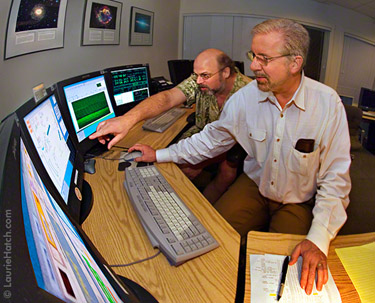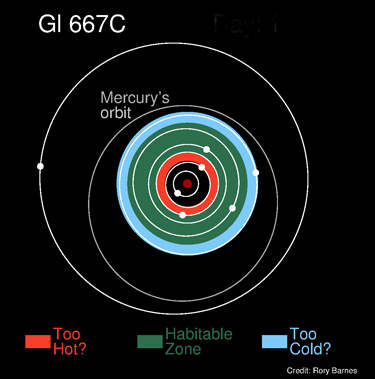Analysis of new and archived observations of a well-studied star known as Gliese 667C have revealed a system with at least six planets, including a record-breaking three super-Earths orbiting in the star's "habitable zone" where liquid water could exist on the planets. This is the first planetary system found to have a fully packed habitable zone.
Steven Vogt, a professor of astronomy and astrophysics at UC Santa Cruz, is on the team of astronomers that made the discovery, which will be published in the journal Astronomy & Astrophysics.
"The three planets in the habitable zone are roughly Earth-sized and only about three to four times the mass of the Earth," Vogt said. "The findings are based in part on data that Paul Butler and I have taken over the past 13 years using the HIRES spectrometer on the Keck Telescope in Hawaii."
The team of astronomers--led by Guillem Anglada-Escudé of the University of Göttingen, Germany, and Mikko Tuomi of the University of Hertfordshire, U.K.--combined the observations from Keck and other telescopes with extensive data collected previously by HARPS (High Accuracy Radial velocity Planet Searcher) at the European Southern Observatory's 3.6-meter telescope in Chile.
"These new results highlight how valuable it can be to re-analyze data in this way and combine results from different teams on different telescopes," said Anglada-Escudé.
Gliese 667C is a very well-studied star. Just over one-third the mass of the Sun, it is part of a triple-star system known as Gliese 667 (also referred to as GJ 667), 22 light-years away in the constellation Scorpius (the Scorpion). This is relatively close to us, within the Sun's galactic neighborhood, and much closer than the star systems investigated using telescopes such as the planet-hunting Kepler space telescope.
Previous studies of Gliese 667C had found that the star hosts three planets, including one in the habitable zone. The new study reexamined the system by adding new HARPS observations and data from other telescopes. The team found evidence for up to seven planets around the star. These planets orbit the faintest star of the triple-star system. The two other suns would look like a pair of very bright stars visible in the daytime, and at night they would provide as much illumination as the full Moon. The new planets completely fill up the habitable zone of Gliese 667C, as there are no more stable orbits in which a planet could exist within the zone.
The habitable zone is a thin shell around a star in which water may be present in liquid form if conditions are right. This is the first time that three such planets have been spotted orbiting in this zone in the same system. The three planets in the habitable zone of Gliese 667C are confirmed to be super-Earths--planets more massive than Earth, but less massive than planets like Uranus or Neptune.
"Finding three low-mass planets in the star's habitable zone is very exciting," Tuomi said.
Coauthor Rory Barnes of the University of Washington noted that the discovery suggests that habitable planets may be more numerous that previously thought. "The number of potentially habitable planets in our galaxy is much greater if we can expect to find several of them around each low-mass star. Instead of looking at ten stars to look for a single potentially habitable planet, we now know we can look at just one star and have a high chance of finding several of them," Barnes said.
Compact systems around Sun-like stars have been found to be abundant in the Milky Way. Around such stars, planets orbiting close to the parent star are very hot and are unlikely to be habitable. But this is not true for cooler and dimmer stars such as Gliese 667C. In this case, the habitable zone lies entirely within an orbit the size of Mercury's, much closer to the star than the habitable zone of our Sun. The Gliese 667C system is the first example of a system where such a low-mass star is seen to host several potentially rocky planets in the habitable zone.
The ESO scientist responsible for HARPS, Gaspare Lo Curto, said, "This exciting result was largely made possible by the power of HARPS and its associated software and it also underlines the value of the ESO archive. It is very good to also see several independent research groups exploiting this unique instrument and achieving remarkable precision."
This research is presented in a paper entitled "A dynamically-packed planetary system around GJ 667C with three super-Earths in its habitable zone," to appear in the journal Astronomy & Astrophysics. The coauthors include G. Anglada-Escudé (University of Göttingen, Germany), M. Tuomi (University of Hertfordshire, UK), E. Gerlach (Technical University of Dresden, Germany), R. Barnes (University of Washington, USA), R. Heller (Leibniz Institute for Astrophysics, Potsdam, Germany), J. S. Jenkins (Universidad de Chile, Chile), S. Wende (University of Göttingen, Germany), S. S. Vogt (University of California, Santa Cruz, USA), R. P. Butler (Carnegie Institution of Washington, USA), A. Reiners (University of Göttingen, Germany), and H. R. A. Jones (University of Hertfordshire, UK).
The team used data from the UVES spectrograph on ESO's Very Large Telescope in Chile (to determine the properties of the star accurately), the Carnegie Planet Finder Spectrograph (PFS) at the 6.5-metre Magellan II Telescope at the Las Campanas Observatory in Chile, the HIRES spectrograph mounted on the Keck 10-metre telescope on Mauna Kea, Hawaii, as well as extensive previous data from HARPS at ESO's 3.6-metre telescope in Chile. Vogt and Butler's work at Keck was funded by the National Science Foundation (NSF grant AST-0908870).




